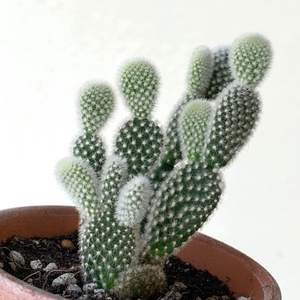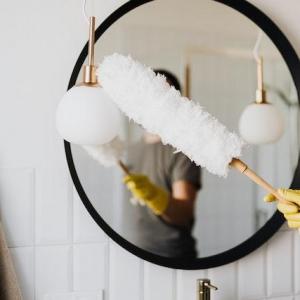Plant Experience
Detail
Opuntia microdasys is an evergreen perennial that forms a dense shrub up to 24 inches (60 cm) tall (occasionally more), composed of green, pad-like stems, up to 6 inches (15 cm) long and up to 5 inches (12.5 cm) broad. It has no spines, but instead has numerous yellow glochids (micro-spines) up to 0.12 inch (3 mm) long at each aureole. The flowers are up to 2 inches (5 cm) across and have broad, yellow tepals, yellow anthers, and dark green stigma lobes. The flowers are followed by round to egg-shaped, up to 2 inches (5 cm) long, red to purplish, spineless but glochid-dotted fruits.
How to Grow and Care
A spot near a south-facing, unobstructed window is most likely to meet Bunny Ears Cactus' need for bright, direct sun. Windows with western or eastern exposure run as second and third choices. While an actively growing Bunny Ears Cactus tolerates indoor summer temperatures as high as 100 °F (38 °C), don't expect it to flower unless you also provide winter temperatures between 45 and 55 °F (7 and 13 °C). Regardless of the season, it likes humidity in the 10 to 30 percent range. Finally, if none of your windows provides adequate light, place the plant 6 to 12 inches (15 to 30 cm) below a cool white fluorescent tube for 14 to 16 hours each day.
The potting soil must drain quickly. Use a commercial cactus potting mix or mix your own. The best container for your cactus is a clay pot just slightly larger and deeper than the plant's root system. It must have drainage holes because a pot without them or a pot that's too large, could make proper watering impossible.
Pot and Potting Soil
A good Bunny Ears Cactus potting soil must drain quickly. Use a commercial cactus potting mix, or mix your own. The best container for your cactus is a clay pot just slightly larger and deeper than the plant's root system. It must have drainage holes because a pot without them, or a pot that's too large, could make proper watering impossible.
Watering
As a heat-loving cactus that grows outdoors in USDA plant hardiness zones 9 through 11, Bunny Ears Cactus has shallow roots adapted to capturing the slightest rainfall. When confined to a pot, the roots are susceptible to rot if they're kept constantly wet. Wait until the top 1 inch (2.5 cm) of soil feels dry before watering Bunny Ears Cactus until water flows from the container's drainage holes. When it is actively growing between spring and fall, regular watering is essential. Once the plant enters winter dormancy, dampening the medium once every 3 to 4 weeks is enough.
Fertilizing
Bunny Ears Cactus benefits from feeding with liquid, 20-20-20 houseplant fertilizer diluted to one-half the label's recommended strength. An alternative, if you're encouraging the plant to bloom, is to use 5-10-10 fertilizer. Either way, fertilize the actively growing plant with every other watering. Fertilizing it more frequently may stimulate too-rapid growth or lead to misshapen pads. Don't fertilize a dormant or newly potted Bunny Ears Cactus.
Pests Control
Cottony, segmented white mealybugs and barnaclelike scale insects attach to a Bunny Ears Cactus' pads to drain sap. To control the pests without having the bristly glochids attach to your skin, dab the pests with cotton swabs dipped in 70 percent isopropyl rubbing alcohol.
Repotting
Expect to repot Bunny Ears Cactus in a container one size larger than its current one every one or two years. Its roots need time to recover from the move, so wait a week before watering it lightly and moving it back into direct sun. Withhold fertilizer for at least a month after repotting. When repotting, use rolled-up newspaper or old carpet to handle the plant to avoid touching the irritating glochids on the plant's pads.
Propagation
Any fully grown pad from this cactus may be broken off cleanly in the early summer and repotted for propagation purposes. Cuttings work best when grouped in threes or more, and should be buried an inch (2.5 cm) deep in the soil. Remember to water regularly to promote the growth of a healthy root system in the first year after propagation.
How to Grow and Care
A spot near a south-facing, unobstructed window is most likely to meet Bunny Ears Cactus' need for bright, direct sun. Windows with western or eastern exposure run as second and third choices. While an actively growing Bunny Ears Cactus tolerates indoor summer temperatures as high as 100 °F (38 °C), don't expect it to flower unless you also provide winter temperatures between 45 and 55 °F (7 and 13 °C). Regardless of the season, it likes humidity in the 10 to 30 percent range. Finally, if none of your windows provides adequate light, place the plant 6 to 12 inches (15 to 30 cm) below a cool white fluorescent tube for 14 to 16 hours each day.
The potting soil must drain quickly. Use a commercial cactus potting mix or mix your own. The best container for your cactus is a clay pot just slightly larger and deeper than the plant's root system. It must have drainage holes because a pot without them or a pot that's too large, could make proper watering impossible.
Pot and Potting Soil
A good Bunny Ears Cactus potting soil must drain quickly. Use a commercial cactus potting mix, or mix your own. The best container for your cactus is a clay pot just slightly larger and deeper than the plant's root system. It must have drainage holes because a pot without them, or a pot that's too large, could make proper watering impossible.
Watering
As a heat-loving cactus that grows outdoors in USDA plant hardiness zones 9 through 11, Bunny Ears Cactus has shallow roots adapted to capturing the slightest rainfall. When confined to a pot, the roots are susceptible to rot if they're kept constantly wet. Wait until the top 1 inch (2.5 cm) of soil feels dry before watering Bunny Ears Cactus until water flows from the container's drainage holes. When it is actively growing between spring and fall, regular watering is essential. Once the plant enters winter dormancy, dampening the medium once every 3 to 4 weeks is enough.
Fertilizing
Bunny Ears Cactus benefits from feeding with liquid, 20-20-20 houseplant fertilizer diluted to one-half the label's recommended strength. An alternative, if you're encouraging the plant to bloom, is to use 5-10-10 fertilizer. Either way, fertilize the actively growing plant with every other watering. Fertilizing it more frequently may stimulate too-rapid growth or lead to misshapen pads. Don't fertilize a dormant or newly potted Bunny Ears Cactus.
Pests Control
Cottony, segmented white mealybugs and barnaclelike scale insects attach to a Bunny Ears Cactus' pads to drain sap. To control the pests without having the bristly glochids attach to your skin, dab the pests with cotton swabs dipped in 70 percent isopropyl rubbing alcohol.
Repotting
Expect to repot Bunny Ears Cactus in a container one size larger than its current one every one or two years. Its roots need time to recover from the move, so wait a week before watering it lightly and moving it back into direct sun. Withhold fertilizer for at least a month after repotting. When repotting, use rolled-up newspaper or old carpet to handle the plant to avoid touching the irritating glochids on the plant's pads.
Propagation
Any fully grown pad from this cactus may be broken off cleanly in the early summer and repotted for propagation purposes. Cuttings work best when grouped in threes or more, and should be buried an inch (2.5 cm) deep in the soil. Remember to water regularly to promote the growth of a healthy root system in the first year after propagation.
Album (2)


Elite Article














